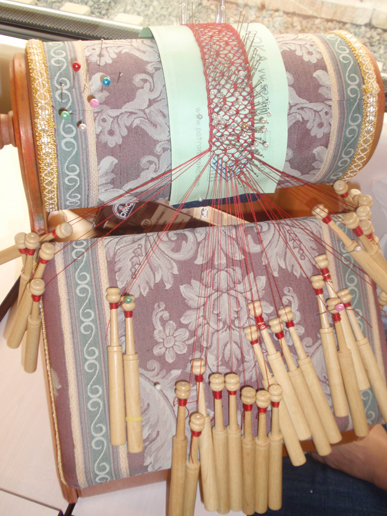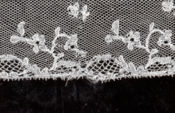The last September-13, I went to Granada, to attend the wedding of a niece of mine. I went by train –and…by the way, it was a very nice trip--. Well, but to my right was sat a very young woman, who was making a bobbin lace. It caught my attention and I started to talk to her, to explain to me that this technique is a little source. She told me she is still not quite ready, because she is learning in an Academy of Granada. She also told me that lace is not much in Andalusia, where it is used that is in Castile-La Mancha. I asked her to let me make a couple of pictures and there was no problem:

The young woman´s Mundillo for bobbin of lace

The bobbins on the "Mundillo"
El Encaje de Bolillos (Bobbin Lace) is a textile lace technique, which involves initially weave threads are wound into coils, called "bobbin", for better management. As work progresses, the tissue is held by pins, fixed on a pad, called "Mundillo". The place of the pins is usually determined by a pattern of little holes in the pad.
The lace can be performed with coarse or fine threads. Traditionally, it was made from linen, silk, wool and cotton subsequently. Also with precious metal wire. Today it is also performed with a variety of synthetic fibers, wires or other filaments.
Among the design elements that can be performed there are fabrics (cloth), nets, ropes, nails, boxes and packing, but not all types of bobbin lace include all these elements.
Many types of lace were invented during the heyday of embroidery (approximately between 1500 and 1700) before the automatic embroidery machines were available.
The appearance of the embroidery machine designed by John Heathcoat in 1806 initially spurred the artisans to invent more complicated designs that machines could not perform, but the mechanization left jobless artisans almost completely. The reappearance of embroidery is a recent phenomenon and, in general, is considered a hobby, although there are still guilds that meet regularly in places like Devonshire (England and Orange County (California). During the European peoples where the lace was once a major industry, especially, Belgium, England, Spain and France, the lace still teach their art and sell their goods, but their clientele is no longer the same, nobility richer passed to the curious tourist.

The type of lace "Valenciennes"

Lace of Malinas
In Galice it was also known the bobbin lace. Concretely Camariñas is a village that gave name to the bobbin laces, which were made in all Galice and which come back again.
They used the linen thread, which was grown in Galice (North western Spain) abudantly. In the cathedral of Toledo, in the first half of the sixteenth century, Galician yarn purchases appear, suggesting that exported to the rest of Spain.
Is this a guipure lace type where the leaves are the basic elements of decoration. They are roses, stars, ferns on a background made with twisted lattice virgulitas and sometimes very complex cross forming this tledown or kites.
But also in Almagro (Ciudad Real, South western Madrid, Spain) you can find a very nice and important lace. In the nineteenth century the most important center of lace production in Spain, a variant of lace made of silk thread, stood at Almagro, being very renowned for their blankets. There, a large number of factories manufacturing vied either by the collection of drawings, either by the number, the artistic taste or stippling.
Bobbin lace and lace are a tradition handed down from mother to daughter and well preserved in this town and some other municipalities of Campo de Calatrava, with which even its renowned blankets are made. There is a museum in Almagro Blonda Lace and municipal property.
Well, I hope that you have enjoyed.
Till soon, kind regards,
Luis.
Sponsored by Costaluz Lawyers.
Please click down here:
